Our president knows things about uranium! So do I!
“We had Hillary Clinton give Russia 20 percent of the uranium in our country. You know what uranium is, right? It’s a thing called nuclear weapons and other things. Like lots of things are done with uranium, including some bad things” – Donald Trump
Most bombs nowadays are plutonium, but that’s a little detail. Nuclear weapons-making, though, is something that beggars my imagination when it comes to complexity, which is why I’ve always been interested in it. These are a few random factoids that stick in my mind from a lifetime of collecting random factoids…
George Kistiakowski was the the scientist assigned to make explosive lenses for the first implosion bombs. The Hiroshima bomb was a gun-type device, in which two subcritical masses were combined by driving one down a pipe into the other; it was very reliable. The “gadget” bomb tested at Trinity was an implosion-type bomb, where critical mass was reached by making the plutonium smaller. (So was the “fat man” bomb tested on Nagasaki) Kistiakowski’s project was to figure out how to machine high explosive lenses to ridiculous tolerances (thousandths of inches) and apparently he nearly went mad with frustration. It required inventing a machineable plastic explosive that didn’t change shape over time, because melting and casting conventional explosive wouldn’t work. “Melt and pour” high explosive! Anyhow, I have never seen them but apparently they exist somewhere: Kistiakowski finally managed to explosively turn a cast iron ball the size of a bowling ball into a compressed cast iron ball the size of a baseball.
The problem of getting explosive lenses to fire in perfect sync is still a big one. The Trinity “gadget” looked like this:
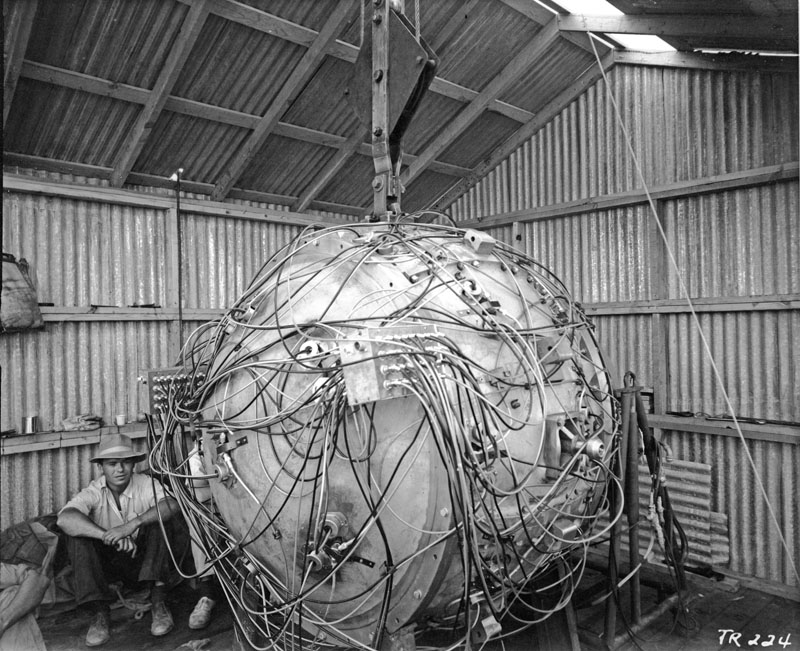
Interestingly, to make a firing/detonator system that’s precise enough for a nuclear weapon requires certain technologies that are pretty much not used anywhere else. So, to this day, if you start looking for “exploding bridge wire relays” you’re probably going on a watch-list somewhere.
The detonators that fire high explosive implosion systems (exploding wire or exploding foil detonators) require voltages in the range of (roughly) 2-20 kilovolts, a complete detonating system may draw currents ranging from 10 to 100 kiloamps. Pulse neutron tubes, used to precisely control the initiation of fission chain reactions, require voltages of 100 to 200 kilovolts, and currents in the ampere range. These currents must be turned on rapidly and precisely, timing accuracies of tens to hundreds of nanoseconds are required. [1]
That’s a lot of electricity!
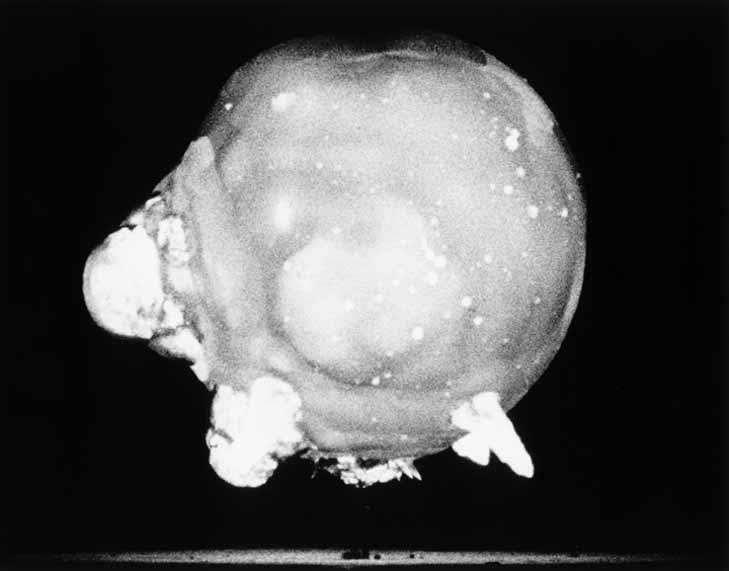
Apparently Doc Edgerton, the inventor of stop-motion strobe photography, consulted on the switching systems. Doc, from MIT, used to freeze motion in his lab by using a totally dark room and arcing a mass of capacitors through a copper bar, which would explode in a brief, bright flash. Doc also shot the famous photos of the Trinity device going off (he may not have been present) – the story is that he asked them about exposure and how far apart in time they wanted the frames, then, in his head, calculated how far the signal would go down the wire at the speed of of an electromagnetic wave in copper, ran off that many feet, and synchronized the bank of cameras so they fired at not-quite-exactly the same time. He got his exposure perfect, too, which means that someone must have given him a rough idea of expected candle-power based on energy release.
 The explosive lenses in a modern device cause an asymmetrical detonation in the secondary; this allows an H-bomb to fit in a conical re-entry vehicle and it’s why computers, during the cold war, were a restricted commodity. During the Manhattan Project Feynman’s team did all the number-crunching for the shockwave surface using Marchandt calculators; modern H-bombs require elaborate and extremely secret calculations. It’s those calculations that Los Alamos lost the software for; it was on some hard drive that went for a walk and never came back. Government computer security at work!
The explosive lenses in a modern device cause an asymmetrical detonation in the secondary; this allows an H-bomb to fit in a conical re-entry vehicle and it’s why computers, during the cold war, were a restricted commodity. During the Manhattan Project Feynman’s team did all the number-crunching for the shockwave surface using Marchandt calculators; modern H-bombs require elaborate and extremely secret calculations. It’s those calculations that Los Alamos lost the software for; it was on some hard drive that went for a walk and never came back. Government computer security at work!
Many modern devices use a thing called a Permissive Action Link (PAL) which is sort of a cryptographic explosion sequencer. If the lenses are made to be slightly asymmetrical (see above) the only way to fire the device is with the PAL that “knows” the exactly nanosecond sequencing fire-order for the lenses. That was invented during the mid-Cold war by Lawrence Berkeley Labs staff, who actually gave the technique to the Soviets in order that the Soviets could build bombs that were harder to steal and hot-wire. Hot-wiring a city buster is more or less impossible thanks to the PAL, but very many warheads are too small to have a PAL. So if you want a crazy release scenario, my old friend who was a mere US Army Major had launch control over the “special munitions” in the guarded van that travelled with his MLRS battery during Gulf War 1.
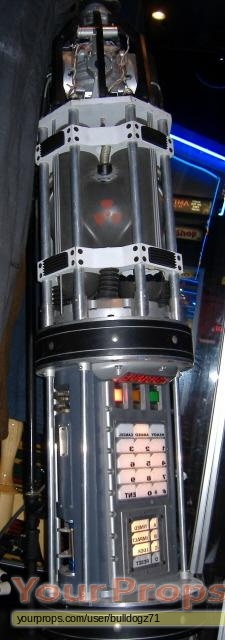 The typical design of a deliverable nuclear weapon divides the “physics package” which is the plutonium, lithium deuteride, beryllium, etc, and the explosive lenses that fire the primary, from the triggering system that is outside. The physics package is a more or less sealed stainless steel unit with a wiring harness that goes into it. Nobody crazy (let alone in their right mind) would want to crack into the physics package and since the layout of the interior is very secret indeed, there’d be a good chance you’d damage something. So, when you see a nuclear weapon in a movie like “Broken Arrow” or “24” you are looking at stupid. Also: they are heavy. In general, you can tell about how much a warhead weighs at any time by looking at the maximum “throw weight” of a ‘non-nuclear’ ballistic missile like the South Korean Hyunmoo-3 [w] – why would anyone go to such trouble to deliver 500kg of conventional explosives? (500-900kg is typical weight for a weaponized nuke)..
The typical design of a deliverable nuclear weapon divides the “physics package” which is the plutonium, lithium deuteride, beryllium, etc, and the explosive lenses that fire the primary, from the triggering system that is outside. The physics package is a more or less sealed stainless steel unit with a wiring harness that goes into it. Nobody crazy (let alone in their right mind) would want to crack into the physics package and since the layout of the interior is very secret indeed, there’d be a good chance you’d damage something. So, when you see a nuclear weapon in a movie like “Broken Arrow” or “24” you are looking at stupid. Also: they are heavy. In general, you can tell about how much a warhead weighs at any time by looking at the maximum “throw weight” of a ‘non-nuclear’ ballistic missile like the South Korean Hyunmoo-3 [w] – why would anyone go to such trouble to deliver 500kg of conventional explosives? (500-900kg is typical weight for a weaponized nuke)..
The detonation system of a nuclear weapon takes a lot of current. One fun fact I learned a few years ago is that the nuclear artillery shell had a generator in the shell body, what was driven by the angular torque of the shell going through the rifled barrel of the gun. Very clever! The only way to fire the nuclear weapon was actually to fire it from the gun; you couldn’t just hook a car battery up to it, or whatever, like you see in bad movies.
By the way, if you ever find yourself in a bad movie with Kevin Bacon fighting you over a nuclear weapon, just compromise any one of the wires in the harness. That way, when the bad guy fires the detonation system, one of the explosive lenses won’t go off at exactly the right time and you’ll get a nasty squirt of hot splashy plutonium going off in some random direction or other, and maybe a bit of a chain reaction that kills everyone nearby, but you won’t get a full yield explosion. That is, apparently, what happened to one of the earliest North Korean tests. I feel bad for whoever cleaned that up!
In the 50s, the US did underground tests and at one point there was a gigantic steel manhole cover sort of thing over one of the deep bore blast sites. After the explosion, the manhole cover was never found. Some physicists did the math and concluded that it may have been blasted out of Earth’s gravity well. Or vaporized. That is still, I believe, unknown.
Centrifuges are highly non-trivial. Centrifuge cascades are really really non-trivial, because they have to be fed with the right amount of pressurized uranium hexaflouride, which is extremely nasty stuff. Dupont invented Teflon for the Manhattan Project; Teflon is one of the few thing “hex” doesn’t destroy over time.
The science of nuclear forensics is very good. Nuclear forensics experts can tell (given enough sample and whatnot) what breeder reactor bred what batch of plutonium, and when – based on very small variances in isotopes. Nuclear forensics experts can tell which centrifuge cascade refined what plutonium, and when, in the same manner. The byproducts of nuclear explosions are a detailed signature of the when and where and who. That’s why nobody should believe that what actually happened during the Vela Incident [2] is unknown. I don’t know and probably you don’t either, but there are people who surely do.
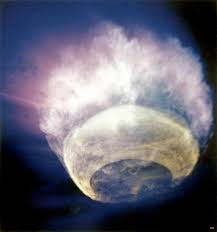
Hardtack Orange
The survivalist fantasy story of someone setting off a nuclear weapon over the US, and crashing our electronic infrastructure deliberately is – just that. For one thing, the US did a massive series of atmospheric tests back in the late 1950s, like HARDTACK ORANGE which was a 3.8 megaton high atmosphere burst. [3] It caused an audible “click” on the radio, and a few automation systems hiccuped, but humanity was not sent back to the stone age. More to the point, any country that was stupid enough to think of trying such a trick on the US would not be smart enough to be able to obtain a nuclear weapon, anyway. And besides, nuclear forensics is good enough that its provenance would be detected and there’s this thing called “The Nuclear Triad” which Donald Trump hasn’t heard of but most of us have: there are ballistic missile subs submerged, where the EMP won’t bother them – but when they hear the “click” they’ll come shed “sunshine from the depths.” (That is the unit slogan of a ballistic missile sub.)
Back to centrifuges: I predicted Stuxnet was a US project when I heard that Iran’s centrifuges were Pakistani RP1s from the A. Q. Khan network. The only other people who’ve got any of those to test against are: Pakistan, and the US. The US? Yeah, when Libya spun down their enrichment efforts, the US was given Libya’s RP1s and they were stored in Oak Ridge, TN. Saddam Hussein’s enrichment program at Osirak, that the Israelis and US bombed, was using calutrons, which are an electromagnetic cyclotron that have a much lower output than centrifuges.
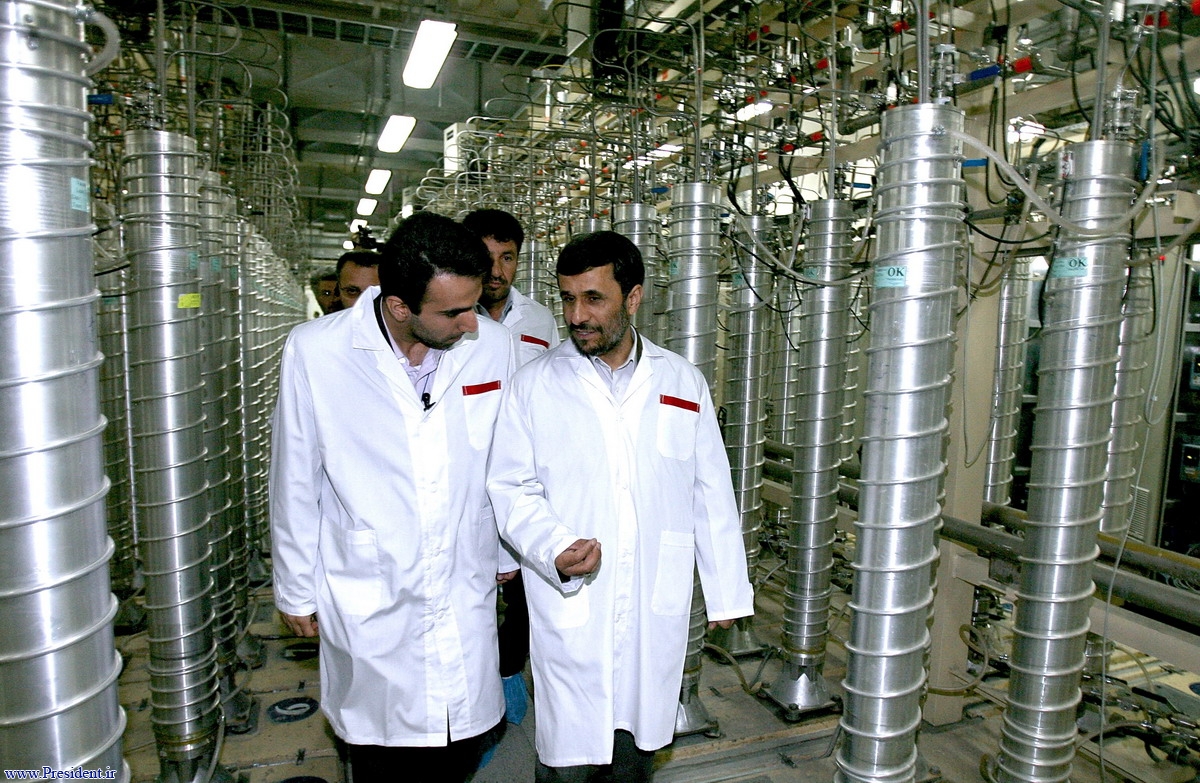 I have saved two of the coolest things about centrifuges for last. OK, sort of: A. Q. Khan, who made Pakistan’s centrifuges, learned how by working for Siemens in Germany. Proliferation is complicated to control. As Feyman said, “the secret of nuclear weapons is that they are possible.” Centrifuges are crazy amazing devices, though: they are magnetically levitated because of problems you’d have with friction, and are usually wrapped carbon fiber and steel. The carbon fiber is to strengthen them: they float in a vacuum and they spin at Mach 2. [4]
I have saved two of the coolest things about centrifuges for last. OK, sort of: A. Q. Khan, who made Pakistan’s centrifuges, learned how by working for Siemens in Germany. Proliferation is complicated to control. As Feyman said, “the secret of nuclear weapons is that they are possible.” Centrifuges are crazy amazing devices, though: they are magnetically levitated because of problems you’d have with friction, and are usually wrapped carbon fiber and steel. The carbon fiber is to strengthen them: they float in a vacuum and they spin at Mach 2. [4]
They spin at Mach 2.
9,000 RPM. In the picture above, you can see some of the crazy feed-lines that move the hexaflouride along. The coils down the side of the housing are refrigerant – it would not do at all to have your centrifuge heat up. The inner rotating cylinder is carbon fiber with magnets embedded in it to levitate it in the vacuum. As it goes from centrifuge to centrifuge it spins up and the exact isotope of plutonium that is being enriched fits through a carefully tuned collector slot. Apparently one of the ways Stuxnet screwed the Iranian enrichment program was by running the centrifuges at a slightly different speed but the controls displayed the speed it was supposed to be spinning. Result: you collect a crappy isotope that was not what you wanted.
I would not be walking through a room full of uranium hexaflouride-carrying things spinning at Mach 2, and smiling. I don’t have that much confidence in human engineering. I’ll watch from a distance, maybe, using a drone, but a centrifuge cascade is one of the very few cold war things I would turn down the chance to visit (and I’ve been to Chernobyl…)
When the Bush administration was squawking about Saddam Hussein trying to obtain high quality steel tubes to make weapons of mass destruction, there were presumably a lot of us who knew that someone was lying.

There is a book called “Eating Grass” by Feroz Kahn, about the Pakistani nuclear program. [amazon] I don’t want to sound patronizing but: holy mackerel the Pakistanis were tenacious and plucky in their pursuit of their nuclear program. The whole book is really interesting but it contains a few nuggets of amazingness. I would quote it directly for you, except my copy of the book is a 15 minute drive away, but basically, what happened is the Pakistanis built their first enrichment facility in the middle of noplace (as one does) and strung up the hexaflouride feeds and started spinning centrifuges (as one does) – and then there was an earthquake. One of the centrifuges, or more, displaced and disintegrated – at Mach 2 it would have been like a grenade going off – and gang-fired the entire cascade. Result: a building full of shattered stuff and uranium hexaflouride gas! The Pakistanis built another enrichment facility.
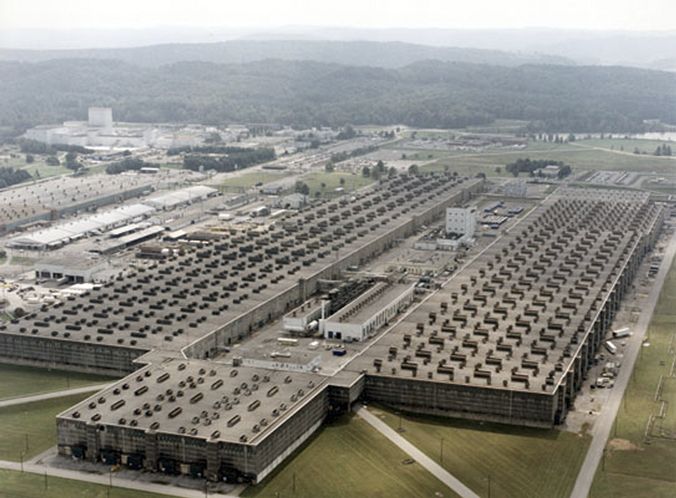
K-25 gaseous diffusion plant, Oak Ridge TN [5]
Today’s generation don’t seem to realize that the nuclear monsters are ready to go at a moment’s notice, to utterly destroy everything in the name of silly nationalist ideology. It’s important for everyone to understand that we should all be “anti nuclear” – these things absorb huge amounts of money and make the world a lot less safe. Huge pieces of the US economy were absorbed by nuclear weapons. For example: the Tennessee Valley Authority build-up was to produce electricity – but not to power the US’ economy: it powered nuclear enrichment.
Wasted effort, one hopes.

Richard Rhodes’ book “Dark Sun” is a good read, it’s almost like a techno-thriller. His “twilight of the bombs” is good but perhaps optimistic.
Richard Feynman’s “los alamos from below” lecture, which can be found on youtube, includes some interesting stories about computing in the early days of the nuclear era (and some fun safe-cracking stories)
“The Nuclear Express” by Reed and Stillman (who are little-known characters who were in thick of the cold war nuclear programs) is really interesting. Reed also wrote a book called “At the Abyss” that is quite scary and talks about dealing with Soviet nuclear legacy items after the collapse of the USSR.
“My journey at the nuclear brink” by Bill Perry is another bunch of interesting stories from someone who was there and did that.
This is some pretty good analysis on the costs of the Manhattan Project.

At one time, this was naughty to have or post
I used to travel with a bunch of nuclear weapon assembly diagrams on my laptop. They’re not secret anymore but at one point, they were probably pretty sensitive stuff. Going into and out of some countries I have had my laptop searched by border police, probably checking my most recently used file list for stuff that might be porn. Nobody’s ever asked about nuclear weapons stuff. Nowadays when I travel internationally, I just take paper notebooks and a pen, and don’t take a laptop anymore. I’m not worried about border-guards in Singapore or Saudi Arabia, but US DHS goons: they scare me.

For those interested in the “gigantic steel manhole cover sort of thing”, see https://en.wikipedia.org/wiki/Operation_Plumbbob#Propulsion_of_steel_plate_cap .
BTW, Plunkett discovered Teflon in 1938. The patent (US2230654) was filed in 1939 and granted in 1941. Rhodes’s “The Making of the Atomic Bomb”, p494, describes the difficulty of making pump seals which were both gastight and greaseless: “The seal material that eventually served at Oak ridge came into its own after the war under the brand name Teflon.”
Could you elaborate on “you collect a crappy isotope that was not what you wanted”? Wouldn’t the mass flow rates be off because of the large differences between the percentage composition of each isotope? This yield difference doesn’t sound hard to detect, and would mostly delay production. The description at https://en.wikipedia.org/wiki/Stuxnet makes it sound like the goal was to stress the centrifuge to make it break down.
That’s all fake physics. The greatest lecture on uranium is on my blog:
http://scienceblogs.de/hier-wohnen-drachen/2017/02/17/uranium-the-greatest-element/
Andrew Dalke@#1:
Could you elaborate on “you collect a crappy isotope that was not what you wanted”? Wouldn’t the mass flow rates be off because of the large differences between the percentage composition of each isotope? This yield difference doesn’t sound hard to detect, and would mostly delay production. The description at https://en.wikipedia.org/wiki/Stuxnet makes it sound like the goal was to stress the centrifuge to make it break down.
As I understand it (I could be wrong, and I would greatly welcome anyone adding any information that improves my understanding!) the Stuxnet attack was a variation of the infamous “Aurora” technique used at Idaho National Labs to destroy a generator by alternating the phasing of the breakers. I’ve seen pictures of the interior of the plant at Bushehr, where the generating system blew apart in a classic Aurora attack, before the enrichment systems at Natanz began to fail. When even a small generator (you can find video of the Aurora attack here) fails in this manner, stuff goes flying. One possibility is that the Stuxnet attack on the centrifuge cascade was done so that – as you say – it would be clear something was wrong, without causing a massive gang-explosion like happened to the Pakistani enrichment plant during the earthquake. Another possibility is that it was done to destroy the production line (I have no idea how one cleans out a centrifuge cascade!) before taking it offline; let it run that way a week, then destabilize all the rotors and let it fail. Another possibility was a deliberate gradual failure that somehow burned rotors out without causing crashes. I don’t know what happened – I wish I did – and the Iranians aren’t talking.
One thing I’m pretty sure: one does not just go on Ebay and buy a centrifuge cascade to test on. The attack was based on very specific parameters. I can’t imagine doing that without a bit of testing first. But I suppose another possibility is that the isotope difference effect was just a side-effect of the phasing used to take down the cascade.
Marcus, I think these are a couple errors in your post. You mention centrifuges as enriching plutonium. As far as I know, centrifuge cascades are only used for uranium enrichment. Of course, my knowledge may be incomplete — I do know that the plutonium from Manhattan Project era reactors did not comprise a single isotope as was hoped, so it’s not out of the question that plutonium enrichment is a thing.
I’ve long been impressed at the remarkable evolution in weapons design. That “yuge” Trinity device had shrunk to basketball size (or so I’ve read) by the time it was used as the trigger in a deliverable thermonuclear weapon. Possibly even smaller by now.
DonDueed@#4:
You’re right that I was mistaken about the plutonium enrichment process. Here’s why I conflated it with the uranium enrichment – it’s the same. You enrich the uranium then use radiation exposure to convert highly enriched uranium to plutonium in a light water reactor.
I actually sort of knew that but didn’t remember it because the whole game is the uranium:

(That’s from my archive of former nuclear weapons secrets – it’s the optimal processing loop for making weapons-grade materials. It is not classified anymore because it leaked back in the early 90s)
Besides, if Hillary Clinton can give 20% of the uranium in the US to Russia, I can dump a few formerly secret docs.
There’s a reason breeder reactors are, ahem, uncompetitive for civilian purposes.
Ah yes, the uranium isotopes can only be separated by physical methods like centrifuges and gas diffusion, while plutonium can be separated from spent nuclear fuel by exploiting the differences in the chemistry of plutonium and uranium.
In the Periodic Table of Videos, a few years ago they showed some chemical reactions of dissolved plutonium compounds (a rather long video with a lot of other stuff, plutonium compounds are handled at 4:40, 8:00 and 13:18).
Marcus, I wouldn’t be surprised if the people who cleaned up the failed North Korean test you mentioned were people the NK government wanted to die in a nasty way.
I wonder if that’s Donald Hornig in the picture of the Trinity device. I knew him when he was President of Brown University. He told stories about sitting up with the bomb the night before the Test, reading a paperback book by the light of a single bulb.
Elementary, Ice Swimmer.
(Couldn’t help myself)
OK, I went back to Rhodes’ The Making of the Atomic Bomb to jog my memory about plutonium “separation”.
There was indeed an issue with plutonium isotopes. The Hanford reactor produced Pu that was mostly the desired isotope 239, but there was also some 240Pu. The problem with that is that 240 has a high rate of spontaneous fission — so high that the contaminated Pu could not be used in a gun-type bomb. The spontaneous neutrons would cause the mass to initiate fission too early, resulting in a fizzle rather than a boom.
But the 240 could not be separated from the 239 by any method then known — the masses are just too similar. That is why the plutonium bomb used an implosion design rather than the simpler gun method.
I have no idea whether plutonium can be produced without the 240 contaminant these days, or if it’s now possible to separate Pu isotopes. It’s probably not worth doing anyway since implosion technology is so mature. In any case, I don’t think anybody has ever used centrifuges to do plutonium isotope separation.
It sounds like they are using tuned lasers to do enrichment now.
I first heard about laser separation back in the 80s. At least some of the versions didn’t pan out, but SILEX is now classified so maybe it’s working.
I’m sure it’s enriching somebody, anyhow.
TNT and RDX are definitely meltable and pourable, here’s the only picture I could find of someone pouring HE:
https://en.wikipedia.org/wiki/Amatol#/media/File:152_mm_shell_production_SA-Kuva_88285.jpg
Supposedly the explosive lenses on a nuke are RDX based.
You mention the PAL links, despite their prominence in movies about stolen nukes, many people would be shocked to find out that the PAL links were not actually used until fairly recently, see:
Launch code for US nukes was 00000000 for 20 years
https://arstechnica.com/tech-policy/2013/12/launch-code-for-us-nukes-was-00000000-for-20-years/
British nukes were protected by bike locks
http://news.bbc.co.uk/2/hi/7097101.stm
I like what you did there.
Patrick Slattery@#15:
British nukes were protected by bike locks
I have plans for an eventual posting on a few tidbits about British nuclear security. But it’s hard to pry confirming details on a lot of that stuff, and I hate doing posts full of handwaving (except about morals, of course, in the philosophical tradition!)
According to Rhodes, Kistiakowski’s frustration was because of tiny bubbles in the melt and pour, which apparently do horrible things to the evenness of the shockwave front. The current explosives are similar chemistry to RDX but apparently are a very stable hard plastic that tools well. And by “similar to RDX” I mean it’s gonna be nitrogens in an arrangement that’s “ready but not eager” to rearrange…
I suspect that an usually high percentage of this blog’s readership has read Schlosser…
And just in case any of you aren’t familiar with Derek Lowe’s writings about things that blow up or stink or both (if you even think at them) .. his “in the pipeline” blog is full of stuff like this:
http://blogs.sciencemag.org/pipeline/archives/2011/11/11/things_i_wont_work_with_hexanitrohexaazaisowurtzitane
Please do. The Official Secrets Act is pretty onerous though, good luck with finding anyone willing to confirm _anything_, but that shouldn’t stop you from writing what you believe to be true. Just put a disclaimer on it, we’ll understand.
Sandia has a youtube channel with a lot of good history:
https://www.youtube.com/watch?v=DQEB3LJ5psk
And you can see a lot of this stuff in person at the Nuclear Museum in Albuquerque:
http://www.nuclearmuseum.org/
I just got a “Survival Under Atomic Attack” pamphlet from the California Civil Defense Office from there.
“Atom Splitting is just another way of causing an explosion.”
Sadly, it probably didn’t escape because of interactions with the atmosphere. Still, you should add more. That is a really fun manhole cover. It may hold the hold the record of the fastest-moving man-made non-microscopic object ever, beating out the Voyager 1 probe (which is the other contender). The real details may not be so fabulous, but the urban legend story is still great.
https://professionalparanoid.wordpress.com/the-fastest-man-made-object-ever-a-nuclear-powered-manhole-cover-true/
http://nuclearweaponarchive.org/Usa/Tests/Brownlee.html
Yes, excessive regulation because of paranoid and ignorant people like you. There’s a reason that no one has an arsenal of U-233 bombs. There’s a reason that no one uses breeder reactors to make weapons. There’s a reason that no one has used a civilian nuclear reactor to get weapons grade plutonium. The reasons are both obvious and simple: It’s cheaper and easier to use centrifuges or custom purpose-built reactors, and civilian nuclear reactors are much easier to monitor by people like the IAEA compared to secret military installations. Several breeder designs, like molten salt reactor, and the fast liquid metal breeder reactor, are not entirely proliferation immune – any source of neutrons is useful to make weapons plutonium – but it’s easier, safer, and more militarily secure, to just start from scratch with centrifuges or a custom purpose-built reactor.
EnlightenmentLiberal @22, I see you concur with my declaration.
Succinctly, I think it’s geopolitics rather than technology or environmental considerations or economics which accounts for the current situation)
—
Fast-neutron reactors can use reactor-grade plutonium, but that itself can be used for nukes as can the uranium being burnt.
With an extreme amount of reprocessing, yes. And some expert testimony that I’ve heard has said that it’s just easier to start from scratch than try to reprocess that. When you add that the plain fact is that no nuclear weapons country has ever done the sort of thing that you’re talking about, I feel pretty confident here.
By analogy, I can also use a particle accelerator to turn lead into gold. Just because I can, doesn’t make it practical, nor anywhere near cost competitive to known alternatives of obtaining gold.
EnlightenmentLiberal, again you concur with my proposition. Thanks.
Poor analogy, inasmuch as I already noted it’s not an economic issue.
To John Morales
My apologies for negligently misconstruing you.